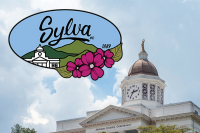Mountains of mushrooms
Is this going to be a bumper year for wild mushrooms? Maybe so, if the rainfall we have been experiencing in recent weeks continues to any significant extent into late summer and fall.
My wife, Elizabeth, and our youngest daughter, Quintin, went on a mushroom foray in Swain County this past Sunday. It was a Father’s Day event of sorts. I’m not sure how many fathers got to go (or wanted to go) mushrooming as a gift, but I did. And I thoroughly enjoyed myself.
It’s still very early in the mushroom season, which will peak from mid-August into early November. But we found mushrooms. One woodland area yielded perhaps 25 beautiful “Lactarius volemus” (one of various species in the “Lactarius” genus, all of which exude a white fluid when cut) that we call “milkys.” These are choice edibles.
Back in the late 1980s, Elizabeth and I took a Smoky Mountain Field School course conducted by Ron Peterson, then the mycologist at the University of Tennessee. This gave us the rudimentary skills required to make accurate identifications. There are about 15 species that we now confidently harvest for the table.
Anyone interested in the natural history of this region should be aware of the Smoky Mountain Field School, which is administered by the University Outreach & Continuing Education Department of the University of Tennessee. SMFS offers courses (usually one-day Saturday outings from late March into early November) on every natural history topic one could think of: orienteering, photography, edible and medicinal plants, wildflower and fern identification, fly fishing, salamanders, mosses and liverworts, geology, elk, bears, nature sketching, stream life, and much more.
A SMFS program listing is available online at: www.outreach.utk.edu/smoky. Or call 865.974.0150 to request a printed catalog.
Related Items
S. Coleman McCleneghan will be instructing two courses this summer that she has designed for beginners interested in learning to identify “Edible and Poisonous Fungi.” One will be taught in the Great Smoky Mountains Nation Park on Saturday, Aug. 29, 9-4 p.m.; the other at Roan Mountain on Saturday, Oct. 3, 9-4 p.m. The fee is $49 per participant. Consult the sources cited above for additional information.
Elizabeth and I never consider ingesting any species that’s in a genus where poisonous species are found. Misidentifying a bird or a wildflower isn’t a big deal, but misidentifying a mushroom that you’re going to eat can be a really big deal.
When I was growing up in piedmont Virginia, my folks never made reference to “mushrooms”; instead, they invariably called them “toadstools” — a negative label that implied they were suspect and not to be fooled with any more than true toads were to be handled because they supposedly gave you warts.
But all of the earliest European settlers in North America (including my ancestors) had come to this continent with a long-standing tradition of harvesting and ingesting mushrooms. And they immediately began harvesting and ingesting North American species that resembled the ones they had been fond of in the Old World. Trouble was that not a few of these proved to be deadly “look-a-likes.”
That situation pretty much cured most of our early ancestors from fooling around with “toadstools.” On the west coasts of the United States and Canada, this “look-a-like” scenario continues to be replayed into this century as modern immigrants from Asia make deadly mistakes when they harvest and ingest species that closely resemble ones that had been choice edibles in their homelands.
Interesting from a cultural viewpoint is the fact that the Native American peoples of both North and South America brought with them to the New World a great tradition of harvesting and ingesting mushrooms which has been continued to this day. One supposes that they have done so by trial and error; that is, the Native Americans no doubt made deadly identification errors, as did the Europeans, but they apparently recorded those errors in their oral traditions and tended not to repeat them.
If you took a basketful of recently harvested mushrooms into a barbershop in Cherokee, a lively discussion as to their identification and where they were found would commence. The Cherokees have their own names for each species and they often know the exact type of habitat in which each was harvested.
“Armillariella mella” is known to the Cherokees as “slicks” and to whites as the “honey” mushroom. The Cherokees call them “slicks” because they “just slide right down your throat.” This is true. Once the cap of a “slick” is heated a little, it becomes viscous, like an oyster, and slides right down, one after the other.
The Cherokees have also traditionally collected “milkys,” “wishys” (apparently the species known to whites as “hen of the woods”), and others.
George Ellison wrote the biographical introductions for the reissues of two Appalachian classics: Horace Kephart’s Our Southern Highlanders and James Mooney’s History, Myths, and Sacred Formulas of the Cherokees. In June 2005, a selection of his Back Then columns was published by The History Press in Charleston as Mountain Passages: Natural and Cultural History of Western North Carolina and the Great Smoky Mountains. Readers can contact him at P.O. Box 1262, Bryson City, N.C., 28713, or at This email address is being protected from spambots. You need JavaScript enabled to view it..









